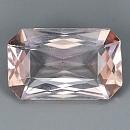|
|
||||||||||||||||
|
||||||||||||||||
|
||||||
|
|
|
|
Morganite
(variety
of Beryl) |
|
| | |
| Discovery: Prehistoric; IMA status: Not Valid (a variety of Beryl) | ||
|
| ||
|
Chemistry |
|
|
| |
|
Be3Al2Si6O18 + Mn | |
|
|
Beryllium Aluminum Silicate + traces of Manganese |
|
Molecular Weight: |
521.21 gm |
|
Composition: |
Beryllium |
5.03 % |
Be |
13.96 % |
BeO |
|
|
Aluminum |
10.04 % |
Al |
18.97 % |
Al2O3 |
|
|
Silicon |
31.35 % |
Si |
67.07 % |
SiO2 |
|
|
Oxygen |
53.58 % |
O |
|
|
|
|
|
100.00 % |
|
100.00 % |
= TOTAL OXIDE |
|
|
|
||||
|
Classification |
|
|
| |
|
Silicates | |
|
8/E.12-10 | |
|
|
9 : SILICATES (Germanates)
|
|
Related to: |
Beryl Group |
|
Members of Group: |
Beryl, Bazzite, Pezzottaite, Stoppaniite |
|
Varieties: |
None |
|
Synonyms: |
Rose Beryl |
|
|
|
|
Crystal Data |
|
|
|
|
|
Crystals prismatic to tabular; may be complexly terminated by pyramids. Also radial, columnar; granular to compact. |
|
|
Rarely |
|
|
|
|
|
Physical Properties |
|
|
|
|
|
Imperfect/Fair on [0001] |
|
|
Conchoidal |
|
|
Brittle |
|
|
7.5 - 8.0 |
|
|
2.71 - 2.90 (g/cm3) |
|
|
None |
|
|
Not Radioactive |
|
|
|
|
|
Optical Properties |
|
|
|
|
|
Various shades of Pink and peachy Pink |
|
|
Transparent to Translucent |
|
|
Vitreous, Resinous |
|
|
1.572 - 1.600 Uniaxial ( - ) |
|
|
0.008 - 0.009 |
|
|
0.014 (low) |
|
|
Weak to Distinct; O = colorless, E = pink |
|
|
|
|
|
Occurances |
|
|
|
|
|
Geological Setting: |
In granites and granite pegmatites, rarely in nepheline syenites. Also in mafic metamorphic rocks, low- to high-temperature hydrothermal veins. |
|
Common Associations: |
Quartz, Feldspar, Muscovite, Lepidolite, Spodumene, Amblygonite, Tourmaline, Topaz, Cassiterite, Columbite, Tantalite. |
|
Common Impurities: |
Fe, Mn, Mg, Ca, Cr, Na, Li, Cs, O, H, OH, H2O, K, Rb |
|
Type Locality: |
n/a |
|
Year Discovered: |
Prehistoric |
|
View mineral photos: | |
|
|
|
|
More Information |
|
|
|
|
|
|
Mindat.org
(Morganite) |
|
|
|
|
Morganite
is known from several sources worldwide but the best
sources of gemmy crystals are Konar and Laghman Provinces,
Afghanistan;
Minas Gerais, Southeast Region, Brazil;
and in
the USA at the Elizabeth R. Mine, Chief Mountain, Pala
District, San Diego County, California, USA. |
|
|
We
have not photographed our Morganite gems yet. Please
check back soon! |
